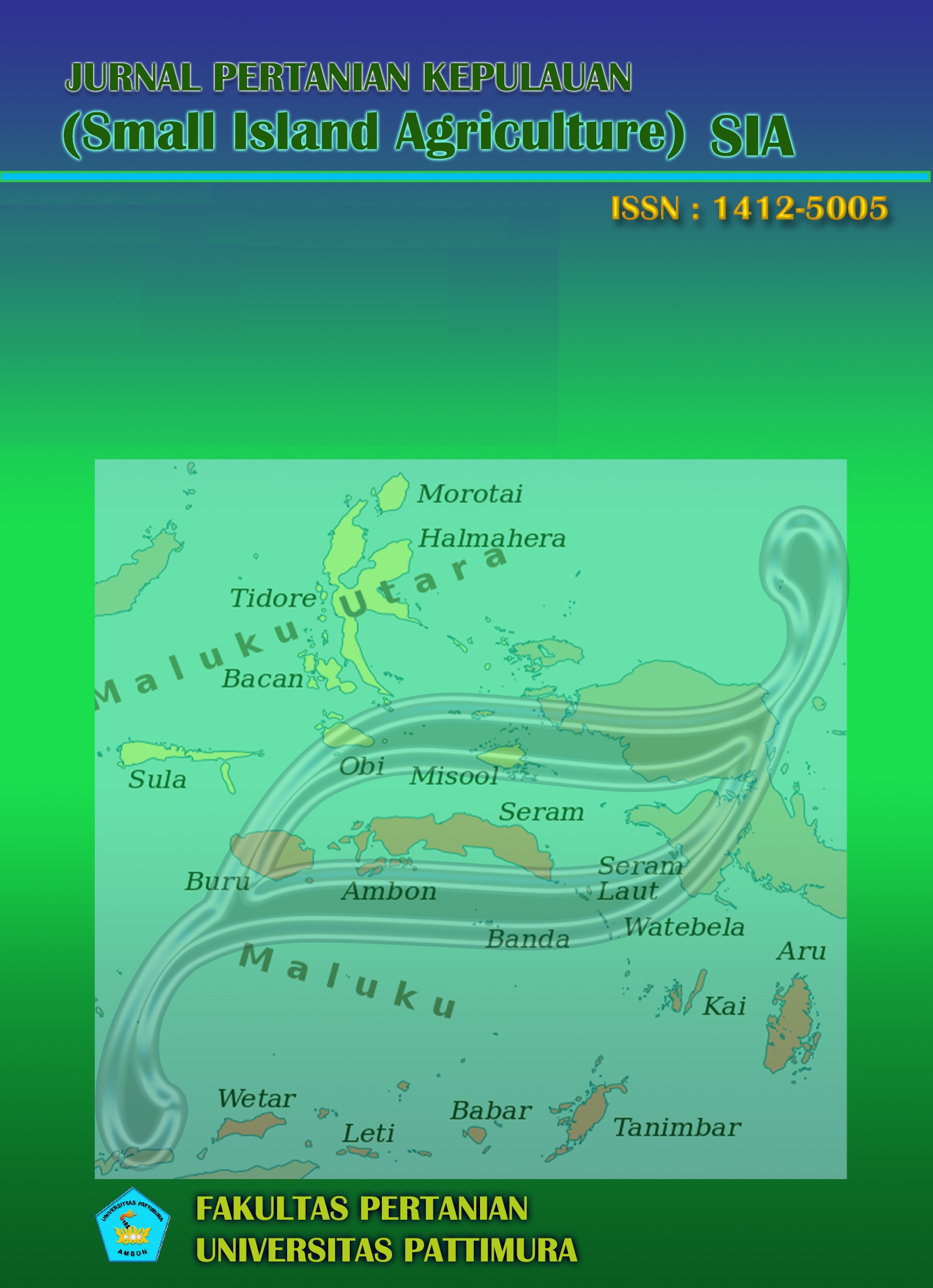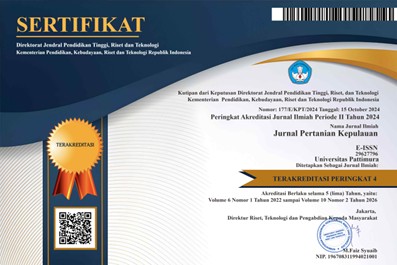Sebaran Jenis-Jenis Gulma Pada Areal Pertanaman Cengkeh di Desa Passo, Kecamatan Baguala Kota Ambon
Abstract
Clove is an important plant that increases the income of the people in Maluku province. This research aimed to understand the forms of weed in the clove planting area. Weed landscape analysis and the square method have been used in the technique. The results showed 21 types of weeds in Band I, consisting of 10 kinds of large leaves, seven types of grass, and four types of ferns. Then, ten types of broadleaves, five types of grass, and three fern types were composed of 18 kinds of in-band II weeds. The study found 15 types of herbs in band III, consisting of 6 types of broadleaves, seven types of grass, and two fern types. Next, in-band IV, 12 kinds of weed consisted of 5 kinds of large leaves, six kinds of grass, and one kind of fern. In-band V, the research results showed nine types of large leaves, six types of grasses, and three types of ferns comprised 18 types of herb. Finally, 13 types of weeds, consisting of five types of large leaves, six types of grass, and two types of ferns, were found in band VI. Broadleaves distribution, i.e., Stachirtapheta indica, Melastoma affine, and Hyptis rhombodea. The key weeds dominating the clove regions are large grasses (Axonopus compressus, Digitaria nuda, Mimmosa pudica, Pueraria triloba, Centrosema pubescens), and the last was ferns (Cyclosorus aridus, Nephrolepis exaltata).
Downloads
References
Barnes D, C. M. (1972). Common malaysian weeds and their control. Kuala Lumpur: Berhad.
Gupta, O. (1984). Scientific weed management. Today and tomorrow’s. Printers and Publisher.
Kanisius, A. (1981). Petunjuk Bercocok Tanam Cengkeh. Aksi Agraris Kanisius.
Mangoensoekarjo, S. (1983). Pedoman Pengendalian Gulma pada Tanaman Perkebunan. Direktorat Jenderal Perkebunan, Departemen Pertanian.
Moenandir, J. (1993). Pengantar Ilmu dan Pengendalian Gulma. Rajawali Pers, Jakarta.
Moody, K., Munroe, C., Lubigan, R., & E C Paller. (1984). Major weeds of the Philipines. University of the Philipines at Los Banos. College.
Oksari, A. A. (2017). Analisis Vegetasi Gulma Pada Pertanaman Jagung Dan Hubungannya Dengan Pengendalian Gulma Di Lambung Bukit, Padang, Sumatera Barat. Jurnal Sains Natural, 4(2), 135. https://doi.org/10.31938/jsn.v4i2.85
Perkebunan, D. J. (2020). Produksi Tanaman Cengkeh Selama Periode 2016-2020.
Soetikno, S., & Sastroutomo. (1990). Ekologi Gulma. Gramedia Pustaka Utama.
Tjitrosoedirdjo, S, Utomo, I., & Wiroatmodjo, J. (1984). Pengelolaan gulma di perkebunan. PT Gramedia.
Tjitrosoedirdjo, Soekisman, Utomo, I. H., & Wiroatmodjo, J. (1984). Pengelolaan gulma di perkebunan. PT. Gramedia. Jakarta, 225.
Wibowo, A. (2006). Gulma di Hutan Tanaman dan Upaya Pengendaliannya. Pusat Penelitian dan Pengembangan Hutan Tanaman. Badan Penelitian dan Pengembangan Kehutanan. Bogor.





.png)


